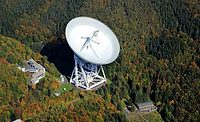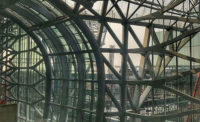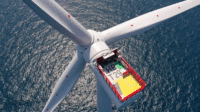Restoring the World’s Largest Art Piece
Villa Regina is an iconic masterpiece with a kinetic art installation designed by Israeli artist Yaacov Agam.


APV’s color specialists test color matches using technology and an eye trained by years of experience. Photo courtesy of APV Engineered Coatings.

During the mock-up process, the Bengoa-Lazer team completed small sections of each color. Photo courtesy of Lazer Manufacturing.

Comparison shows the visible difference between the original faded acrylic paint (outside blue rectangle) and the new NeverFade PVDF-based coating (inside blue rectangle). Photo courtesy Lazer Manufacturing.




Repainting a 31-story building is never an easy job. But when that building is also the canvas for what is arguably the largest art piece in the world, the challenges are even greater.
Built in 1982, the Villa Regina Condominium, located on Miami’s Brickell Avenue (often dubbed “The Wall Street of the South” and “Millionaire’s Row”), overlooks Biscayne Bay and sits on the site of a former water-front mansion. Designed by Cleveland-based William Dorsky Associates, the building won a design award from the Society of American Registered Architects.
Several years after the luxury condo building was constructed, the developer sought to spur sales by giving its exterior an eye-catching new look. He hired famed Israeli artist Yaacov Agam, known both for his large-scale installations and his innovation in kinetic art, to create a 300,000-square-foot masterpiece on the condo’s façade. The building’s angles and the recessed surfaces created by its balconies lent themselves perfectly to creating the kinetic, rainbow effect, popular in Agam’s work, which changes perspective as the viewer moves. As one critic stated of the artist, “He does not impose on the spectator his point of view, but invites him into the game of choosing his own viewpoint.”
Indeed, the viewpoint of the Villa Regina façade changes dramatically, depending on whether one is viewing it from an adjacent building, the marina, the Bay, Interstate Route 95, or the Rickenbacker causeway that connects Miami to barrier islands. Four decades later, it remains an iconic structure and fulfills Agam’s initial aim to animate the entire neighborhood.
Southern Florida Climate Takes its Toll
The passage of time and the sunny, humid, salt-air-laden climate of southern Florida quickly began to take a toll on the 40 vibrant colors comprising Agam’s creation. To keep the building from becoming shabby looking and unbefitting both Agam’s vision and the property’s high-end prestige and value, the Condominium Board of Directors began a costly and disruptive cycle of having the façade repainted every seven years with an acrylic-based coating.
“Even though acrylic paint technology has improved over the decades, we were not getting the 10-year lifecycle promised by the manufacturer,” said John R. Fernandez, General Manager, Villa Regina Condominium. “Soon after repainting, the bright, lustrous colors began to fade, especially the blues, yellows, reds, and purples. The chalking became easily noticeable, and the colors no longer popped.”
More Than Appearance
In search of a better solution, Fernandez connected with Michael Roberts of Lazer Manufacturing. A fourth-generation family company dedicated to servicing and educating the building industry, Lazer offers a variety of commercial, residential, and architectural building products. They provide clients with time-tested expertise in what works—and doesn’t—when it comes to creating sustainable building surfaces.
“Some in the paint and coatings business think they’re being successful if they get the opportunity to re-coat the same building over and over,” Roberts said. “Instead, we believe we are successful when we put the right coating on the right building and have that coating last in accordance with the property owner’s objectives.”
One of Roberts’ first tasks was to help Fernandez and the Condominium Board appreciate the difference between various types of coating technology. He pointed them to previous projects he spearheaded in the area, all of which used a PVDF-based coating, NeverFade® with Kynar Aquatec® from APV Engineered Coatings.
With super-strong carbon-fluorine bonds that do not break down under exposure to the elements, this coating has consistently demonstrated an ability to resist film erosion and fading in high-UV settings like southern Florida. Combined with the coating’s complex inorganic pigments, the PVDF resin helps the coating resist film erosion and chalking. This long-term performance allows APV to offer a 15-year product-and-labor guarantee that the coating will not fade by a Delta E of five or higher. Transferable to future building owners, the guarantee is unique to the architectural coatings industry.
The same properties that allow the coatings to resist color fading also allow them to resist the dirt, bugs, mold, and mildew that can turn a vibrant building exterior into a maintenance-intensive eyesore. While some exterior-grade acrylic-based latex coatings may claim exceptional cleanability or hydrophobic properties, this performance may only last for a short period, because over time the additives, pigments, and resins in these coatings break down, creating a chalky residue. Eventually, this chalked coating wears away from the substrate—or is washed away by rain, wind, pressure washing, or cleaning—until the coating film is gone and no longer protects the substrate, leaving it bare and open to further damage from the elements. The chalky residue also serves as a food source for mold and mildew growth, which further degrades a building’s appearance and creates cleaning and maintenance problems.
“While NeverFade has over 20 years of demonstrated fade-resistance performance, the coating does more than just freshen a building’s appearance,” Roberts said. “It also upgrades the entire building with a sustainable solution that will protect the substrate from further damage, reduce maintenance time and costs, and eliminate the need for and disruption of repainting every five or seven years as is common in southern Florida.”
Matching a Rainbow of Hues
Calling Agam’s Villa Regina masterpiece “colorful” may be an understatement. Its 40 colors range from a citrusy yellow to a deep purple, and every shade in between. In the seven years since the building was last painted, the southern Florida exposure faded the original colors by 20 Delta E units. Fortunately for the APV team tasked with creating 40 custom-color-matched formulas, Villa Regina maintained a “color book” of the original paint colors from Agam’s design.
APV chemists and color specialists knew they were up for the job and worked diligently in the lab over a period of three weeks to get the colors perfect, using a combination of art and science. Once they had a base formula developed, they employed a photo spectrometer to guide the right amounts of red, yellow, and blue pigment to add, and adjusted each color’s shade, tint, and tone. Then, using expertise developed over decades of color-matching experience, they used their “artistic eye” to make sure the coating colors matched the reference book colors perfectly—not just in the lab, but also outdoors in ambient light conditions.
“Color matching can be arduous, but thanks to our hard work, experience, and mastery of the process, APV can color match a wide variety of shades in a fraction of the time it takes most coatings companies,” said Roger Errington, Color Specialist, APV Engineered Coatings. “Plus, we can produce much smaller batch sizes than other companies, allowing architects and building owners to more easily incorporate a variety of colors into their project without unnecessary waste.”
“APV takes a unique approach to color,” added Ernie Porco, Product Application Engineer, APV Engineered Coatings. “While some paint manufacturers tout their ‘color of the year’ and push customers to their color vision, we let the customer decide. By custom-formulating each batch of NeverFade to the customer’s exact color specifications, we allow the building to reflect the owner’s brand standards, school colors, or any color aesthetic they desire. Project specifiers are better able to design with and specify bright and bold colors, secure in the knowledge that those colors will remain true for the long term.”
Mock-Ups Help Validate Colors and Coverage
Villa Regina chose its trusted building services contractor, Bengoa Construction, for the first phase of the project—one line of five high-visibility drops comprising about 22,000 square feet of the condo’s façade. NeverFade-certified applicators like Bengoa go through special training to learn about the chemistry behind the product. They also learn details around pre-job testing, color matching, application mock-ups, on-the-job troubleshooting, and post-installation quality assurance, all providing confidence that the coating will perform throughout its 20+ year lifecycle.
“We implement a careful quality control process, as well as keep a detail record of our inspections,” said Jose Bengoechea, President, Bengoa Construction, Inc. “We know to pay special attention to film thickness, as well as environmental conditions like the temperature of the surface being coated and the amount of moisture in the environment. This attention to detail, and the methodical process we employ, allows building owners to get the long, fade-free lifecycle promised.”
“By certifying their contractors and working with them so closely during the entire process, APV provides us with peace of mind that we are receiving the highest level of coating science, plus disciplined application that helps the entire project run smoothly and leads to the results our tenants demand,” added Fernandez.
To ensure that the coatings would apply at the proper thickness and match the intended colors once installed and dry, the Bengoa and Lazer teams worked hand in hand to coat small mock-up sections for approval by the Condominium Board. After an inspection by the project’s engineer of record, the team began the mock-up process by thoroughly cleaning the cement and stucco surface, using a 500-psi water blasting process to make sure any de-bonded existing coating was removed. They then repaired cracks and other minor damage caused by water intrusion. After priming the surface with APV’s W-1500 Universal Primer, the topcoats were applied by roller. The team conducted adhesion testing to ensure proper intercoat adhesion.
“As soon as we got the mock-up sections done, the color difference between the original, faded acrylic paint and the new topcoat was dramatic,” said Roberts. “Four months after the mock-ups were completed, they still look next-day fresh.”
Showpiece for a Sustainable Future
With mock-ups approved by Villa Regina’s Condominium Board, work has commenced on the initial five-drop line. The goal is to use the line as a showpiece that will engage the building’s tenants and the community, while planning for completing the entire building within the next two years.
“We expect to finish this initial line within about eight weeks, depending on the weather,” Bengoechea said. “As we do with every project like this, we’re being careful to respect the condo’s tenants and their safety throughout the process by locking every balcony on the line until we’re completely done. We’re also providing overhead protection with scaffolding and closing off access to certain ground-level areas.”
“The Condominium Board is extremely pleased to see the project’s progress, the eye-catching colors, and our overall efforts to maintain the building,” Fernandez added. “Even beyond our tenants, we’re getting a lot of great buzz from other property managers and area residents who are excited to see our landmark taken to the next level in long-term sustainability.”
For more information, visit APV's website, here.
Looking for a reprint of this article?
From high-res PDFs to custom plaques, order your copy today!













